|
NETIF PROJECTS
Nepal Tourism, Outdoor & Environment Development Project (NTOEDP)
Phase II - Year 2012:
NETIF has been implementing Nepal Tourism, Outdoor and Environment
Development Project (NTOEDP) with the support from Suman Latu :
Finnish Outdoor Recreation Association with the aim of developing
Better Environment for better tourism .In the NTOEDP Phase I
(2009-2010), NETIF developed the Kathmandu Valley Cultural Trekking
Trail (KVCTT).The trail starts from Sundarijal via Shivapuri
Nagarjun National Park, passing through Mulkharka, Chisapani,
Nagarkot, Dhulikhel, Namobuddha,Balthali and ending in Panauti.
The main problem of the project area is that there are not enough
environmental considerations in tourism sector and among the local
communities resulting a lack of community involvement in tourism and
less people benefiting from tourism. The direct objective of the
present project is that more people in rural and semi-rural
communities could benefit from tourism. This objective can be
achieved by developing community-focused tourism through trekking
trail development, community-based tourism centres, trainings in
product development, promotional activities and establishing
linkages between private sector and communities.
The PROJECT’S expected outputs of the project are
1. Construction of micro infrastructure (tourist shelters, public
toilets, route markings, route upgrading) along the trail.
2. Enhanced capacity of the local people in tourism and environment
through trainings.
3. Product upgrading and promotion.
4. Improved networking and communication with other actors of
tourism to enable better environment for better tourism.
Concerning Output 1 (Constructing of micro infrastructure)
In 2012, project supported local "Tourism and Environment
Development Committees" to construct additional tourist shelters,
incinerator ,waste collection centre, drinking water facility and
provisioned public toilets in fragile areas where the volume of the
tourists is increasing every year. The toilet construction were
initiated in Dhaap area in Chisapani , view tower in Nagarkot and
Devi temple in Dhulikhel where as tourist shelters was constructed
in Okhereni village and Nagarkot at the Himalayan panorama view
point .The community house constructed in past with the initiation
of NETIF in Mulkharka and Nagarkot have been upgraded as Information
cum Handicraft shops. Similarly Nature Guide Office cum Tourist
Information Centre has been established in Sundarijal. NETIF expects
that the tourists going for trekking to KVCTT and Lantang via
Sunadrijal will be able to get sufficient information about trekking
and services available from the region. Besides constructing new
shelters and toilet, NETIF also continued to renovate and maintain
the shelters, community house, trails and toilets constructed in the
earlier phases of the projects in 2012.
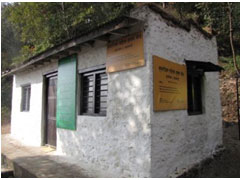
Photo: Nature Guide Office cum Tourist Information Centre
Likewise, NETIF identified and branded other hiking and trekking
trails besides Kathmandu Valley Cultural Trekking trail in Shivapuri
National Park. NETIF believes that the identification,
classification and branding of new trail will yield benefits to the
communities living further away from the main classical trail.
Secondly it will also reduce the excessive pressure of visitors in
the classical trail. The promotional materials like publication of
tourism and outdoor activities information boards, tourist maps and
leaflets were extensively carried out to promote new hiking and
trekking trails. Additional numbers of waste collection baskets,
direction signs were placed along the KVCTT including in the new
trekking trail from kakani.

Photo: Tourists seeing the information board along the trail in
Nagarkot
Concerning output 2 (Enhancing capacity of the local people in
tourism and environment through trainings.
Development of model green enterprise, "Mushroom Cultivation" in
Mulkharka, Dhulikhel and Nagarkot has been successfully initiated in
2012.The team of farmers is successful in producing Oyster mushroom
on regular basis. NETIF has initiated a micro financing program to
the villagers to practice of organic farming method and mushroom
production in a larger scale to the community members by making the
revolving fund available. To scale up the capacity of the hoteliers,
a monitoring and on the spot feed back by the GATE college to
enlarge of the hoteliers practicing the knowledge acquired from the
past trainings such as Lodges and Small hotel management” & Food
preparation and Hygiene trainings were conducted by NETIF before
each tourist season.
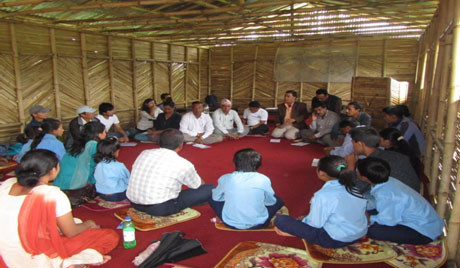
Photo: Eco club meeting with Local Stakeholders, Community, School
Principals’ and Students in Sundarijal
The other activities completed by NETIF include, formation of eco
clubs and Environment conservation training program in 4 Schools
(School Eco- club) in coordination with SNNP. NETIF initiated
several meetings, workshops with local clubs, guides, students,
teachers in the project area and later they were mobilized through
sensitization on waste manage along the trail. The local communities
along the trail are being regularly mobilized through cleanup
campaign on various special occasions such as World Environment day,
World Tourism day.
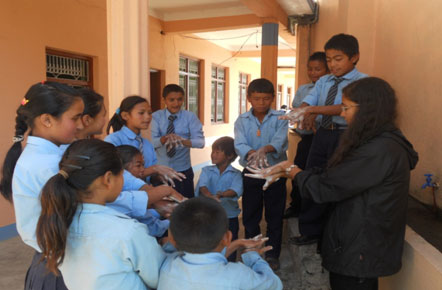
Photo: Environmental awareness program by Rotaract in one of the
scool in SNNP
The local people of Chisopani were oriented through organizing a
workshop on the responsible tourism practices and code of ethics.
The sustainable tourism development initiated by NETIF is an
approach for poverty alleviation, call for the conservation of
natural and cultural heritage. It advocates on jobs to local people,
incentives for environment protection and cultural preservation and
improves understanding among the visitors, host communities and
tourism entrepreneurs. Keeping this view as a guiding principle,
NETIF published and disseminated Sustainable Tourism Guidelines by
localizing Guidelines developed by UNWTO.

Photo: An Interactive Workshop for the promotion of the Responsible
Tourism in KVCTT
The Information and biodiversity conservation awareness board on
sustainable tourism have been placed in Sundarijal , Mulkharka, and
Chisopani. Similarly, community radio programs on environment
management were develop and aired through community radio in
Dhulikhel and Kathmandu to educate the general public on value of
preserving nature.

Photo: Training for the Ecosan users in Sundarijal
The other activities initiated by NETIF in project area include
Initiation of "Open Defecation Free Zone" along with construction of
ecological sanitation pit type toilets in Okhereni, Kune, Mulkharka
and Chilaune. More than 200 such toilet pits and pipes have been
distributed to the villagers in coordination with the Department of
Drinking Water and Sanitation, Government of Nepal. The villagers
are expected to construct the toilet walls with their own effort
bearing the cost individually. Also, 2 day training on Eco San
(Ecological Sanitation) toilet instillation was carried out in
Sundarijal.
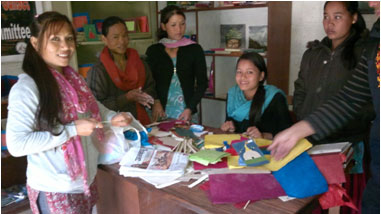
Photo: Women entrepreneur making handicrafts in Nagarkot
Handicraft training was completed in Nagarkot for the differently
able people living in the area and a free space in Tourist
Information Centre was provide to start a handicraft shop where they
can sell their finished products. A survey for Home stay development
was carried out to identify the in the potential home stays in the
villages lying close to the trail. The tree plantations were
extensively carried out in Nagarokot, Dhulikhel, and Sundarijal. The
local youths from Mulkharka were trained in House wiring and
plumbing in coordination with other development partners like German
Development Cooperation (GIZ) and the trainees were introduced in
hotels nearby for their services.
Concerning output 3 (Product upgrading and promotion.)
Like as in 2011, several promotional activities were carried out in
2012. Similar, hoarding boards including tourism resource map has
been developed and familiarization trips have been completed. At
least 3000 brochure were published and distributed various events.
In addition to events, NETIF has been regularly updating web pages,
publishing and disseminating brochures and maps and guidelines for
responsible tourism. So far Lonely Planet Guidebook 2012, VIVA
National Travel Magazine, ECS magazines have already featured the
Kathmandu Valley Cultural trekking trail.

Photo: Orange Blossom hiking event of 2012
NETIF has been promoting the Kathmandu Valley Cultural Trekking
trails through various approaches in different occasions. One of the
main approaches of NETIF is to organize hiking and trekking to the
trail by involving tourism actors more specially trekking agents,
media houses, travel writers and Trekking Agents Association (TAAN),
students, expatriates, embassies for the promotion of the area. The
hiking events have been conducted in various themes such as
Rhododendron blossom, Momo festival, Orange blossoms etc to promote
local products to tourists seeking authentic experiences. Such
activities have become effective tool to inject tourism for poverty
alleviation as the hikers directly go to the destination and
interact with local people and consume local food and services.
Concerning output 4 (Networking and Alliance Building)
In the Year 2012 NETIF continued to develop strategic partnership
with major stakeholders of tourism and environment management in
Nepal. The aim of strategic partnership development were to share
the lesson learned from each other and bring larger alliance to
contribute in the policy dialogue with the government of Nepal. In
this process NETIF has been regularly meeting with Shivapuri
National Park and local communities for development of Buffer zone
Management Committee to ensure greater involvement of local people
in park management and sharing of revenue for local development.
Similarly NETIF built alliance with Sundarijal VDC and Department of
Water and Sanitation Kathmandu to built strong synergy by harmonize
the activities of NETIF with the National Satiation Plan of Action.
Likewise NETIF also is in regular contact with a Bagmati
Civilization High power committee concerning Baghmati conservation
issues more specifically for environment management and waste
management at Bagmati corridor. NETIF also has been sharing ideas
and information with Nepal Tourism Board, Ministry of Tourism and
Civil aviation for the promotion of responsible tourism in Nepal.
Similarly, research and documentation on NTOEDP has been extensively
carried out. So far 9 students perusing Masters Degree in the
various universities of the world have completed their theses on
NTOEDP.
The achievement made by project in the year 2012 is summarized
below.
Related to output 1: Construction of micro infrastructure (tourist
shelters, route marking, route upgrading).
• 2 Tourist shelters and a drinking water in Okhreni.
• Renovation of a Stupa in Okhreni
• Three toilet constructed ( Chisopani / Nagarkot and Dhulikhel )
• Construction of waste collection centre in Dhulikhel
• Additional incinerator in Chisapani
• Eco- trails upgrading and maintenance (in between Sundarijal,
Mulkharka, Chispani and Jhule areas).
• 200 signage placed along the trail including in new trail from
kakani to Chisopani.
• Two Community centres upgraded to multifunctional centres such as
Information Centre, Tea/ Coffee shop and Souvenirs shop.
• Established Tourist Information Centre in Sundarijal.
• 2 Tourist information Boards placed in Sundarijal
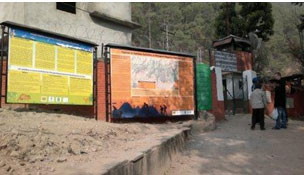
Photo: Information Boards placed in Sundarijal
Related to Output 2: Enhanced capacity of the local people in
tourism and environment through trainings.
• Three new tourism based community organisation formed
(Balthali Environment and Tourism Development Committee, Dhulikhel
Hotel Association and Kakani Environment and Tourism Development
committee)
• Formed student Eco club formed in Nagarkot.
• Organised two local level workshops
• Contribution for Bagmati and Bishnumati conservation activities
(in coordination with Global Peace Association and Common Concern
Nepal (CCN)
• Contribution in the master plan of Nagarkot and Dhulikhel
• Regular social mobilization for cleanup campaign on various
occasions along the trail.
• 275 additional waste collection baskets and rings placed along the
trail (including new trail).
• 25 local people trained in eco san toilet construction.
• 200 villagers sensitised in the initiation Open Defecation Free
zone of Okhereni, Kune, Mulkharka and Chilaune
• 200 eco san toilet pits and outlet pipes distributed to the
villagers.
• Tree plantation activities carried on in Nagarokot, Dhulikhel, and
Sundarijal.
• 25 disable people from Nagarkot trained in a 7 day long handy
craft training.
• 40 people trained in Responsible tourism code of ethics in
Chisopani.
• 15 youths trained in electric wiring and plumbing in Mulkharka (
in partnership with GIZ)
• Book donation to the Eco club schools and Library Formation in
Sundarijal by NETIF
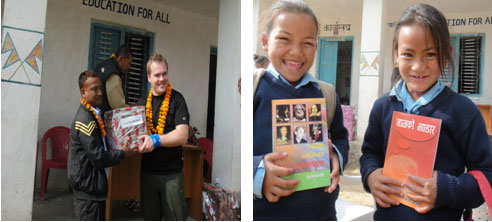
Photo: Mr. Panu kononen from Soumen Latu donating the books to the
school(Right); School Girls were cheerful holding the donated books
in hands
• Regular monitoring and follow-up of food and accommodation quality
(in coordination with GATE College)
• 1 support in the initiation of tourism based green enterprises (
mushrooms )
• Initiation of home stay development program in Okhreni and
Mulkhara
• one year environment health and sanitation awareness and training
programme for the students of four selected schools completed ( in
coordination with Rotract club from Lalitpur district, Nepal Red
Cross Society and Kathmandu University)
• Support in the initiation of Open defecation program in Sundarijal
VDC
• Support to Shivapuri National Park for development of Buffer Zone
Management Committee.
Related to output 3: Product upgrading and promotion.
• Two events of hiking (Rhododendron blossom hiking event in SNNP
and Orange Blossom hiking event in Dhulkhel- Namobudha – Balthali
• Two international media coverage of Kathmandu valley trekking
trail published in tourism media( VIVA city magazine and Lonely
planet guide book)
• Regular update of NETIF home page.
• 3000 brochures published and distributed.
• 1000 tourism Maps of Kathmandu Valley Cultural trekking trail
published.
• The project showcased in 2 National tourism marts/fairs
Related to output 4: improved networking and communication with
other actors of tourism to enable better environment for better
tourism.
• Information boards on route branding, classification and outdoor
activities prepared and placed in Sundarijal,
• Development of responsible tourism guidelines boards in compliance
with UNWTO.
• 2 information boards on responsible tourism prepared and placed
Sundarijal , Mulkharka, Chisopani ,
• 4 information boards on wildlife and biodiversity conservation
developed and placed in Sundarijal, Mulkharka and Chisopani.
• NETIF Participated in 12 workshops/meetings organised by various
actors of tourism development in Nepal with direct functional
relationship with Department of Drinking Water and Sanitation, GON ,DDC/VDC,
Shivapuri- Nagarjuna National Park ,Rotract club Lalitpur , Nepal
Red Cross Society and Kathmandu University, NTB (STN), Himalayan Map
House.
• 9 project research/documentation completed.
Project Impacts:
Several visible impacts of the project can be observed after its
four successful years of implementation. Some of the tangible
impacts are highlighted below.
Strengthen capacity of CBOs
CBOs can plan and identify their needs in tourism themselves.
Additionally they are aware of the value of conservation of
biodiversity, hygiene and sanitation in tourism. They can
independently plan and acquire resources from other agencies.
Therefore they are more capable in comparison with 2008.
Improved networking among the broader stakeholders
It has been observed that a culture of broader level of stakeholders
working together for tourism and environment has started in Nepal.
NETIF has been initiating such campaign from the beginning of the
project. NETIF has also established a strong working relationship
with, government line agencies, Local bodies, ICIMOD, HAN, STN, TAAN,
NTB, GPYC, GPY, CCN, Rotract Club-Lalitpur, Rotary club Dhulikhel,
Chamber of Commerce- Dhulikhel etc.
Better facilities for tourist’s ad local communities
The trail has tourist shelters, toilets and signage at appropriate
location along the trail. Similarly the trails are regularly
maintained after each rainy season. Even the trail are branded and
classified according to their nature ease. Therefore each trekker
can enjoy the trail as per their wishes, which in fact is a better
facility for the tourists compared with that of 2008.Similarly,
local communities also have started obtaining more benefits from
tourism. Firstly they are aware about their rights and
responsibilities in tourism and environment management locally,
secondly, they have new skills and expertise in managing tourism
based micro enterprises such as small lodge and hotel management,
guiding tourists, cultural
programme performance, vegetable production, handicraft production,
through which they have supplementary income in addition to their
income of farming and agriculture. Finally they have more jobs
locally, in comparison with 2008 as more new enterprises are in the
operation along the trail. The local people take pride and ownership
of community buildings, tourist shelters, market information and the
trekking trail which can be used by them for their well being.
Changed in the attitudes and behaviours of local communities and
stakeholders
The training and awareness sessions and campaigns have brought
positive change in Shivapuri National Park. The students have
started sharing their knowledge with their parents, relatives and
friends on waste management and environment protection, personal
health and hygiene. The books donated to the schools have been
useful for enhancing their knowledge in environmental conservation.
The students can easily describe the locals about what they have
learnt during the training. Similarly, the local communities have
gradually started using the rubbish bins properly to keep their
household and community neat and clean. Similarly, they are
friendlier with the outsiders in their village. The trekkers are
also gradually becoming more responsible and culturally friendly
while travelling in the local communities. The tourism entrepreneurs
have also started buying goods and services locally for operating
their business. The quality of the services is gradually improving
and they have concern over the waste management and water and fuel
wood shortages in their locality. This change in the attitudes of
the local communities and the stakeholders is the result of NETIF's
campaign on responsible tourism awareness along the trail.
Changed in the attitudes and behaviours of students and parents:
The environment conservation training conducted by NETIF in 4
schools of Shivapuri National Park have been effective in terms of
change in knowledge, attitude and practice of students which has
been admired by respective school Principals and parents. The
students described to the locals about what they have learnt, these
sorts of activities have helped in building up their leadership
quality. The training given to the students has brought positive
change in Shivapuri National Park. The students have started sharing
their knowledge with their parents, relatives and friends. The
students are also playing the important role in constructing
individual toilets in their respective villages in supporting a
Sundarijal VDC the Free Open Defecation Zone.
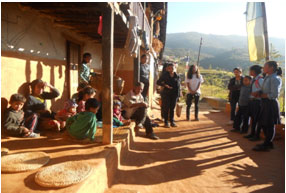
Photo: Eco club students sharing their experiences with their family
Improved visitors satisfaction on trekking trails and accommodation
A survey conducted by NETIF on visitors’ satisfaction along the
trail in March 2012 observed that 70 percent of the trekkers were
satisfied with the condition of the trail .Similarly 75 Percent of
the trekkers were also satisfied with the availability of direction
signs and resting shelters along the trail. Among them 25 percent of
the trekkers strongly recommended for the improvement of garbage and
waste disposal management in the region. Concerning the satisfaction
of accommodation, about 75 percent of the trekkers were satisfied
with the food and beverages, cleanliness and sanitations of the
lodges and hotels and about 25 percent of them have strongly
recommended for room heating facilities in the lodges and hotels in
Chisapani. These facts reveal the fact that the project has been
able to address the wishes of the visitors in the area to some
extent.
Improved in the flow of tourists, revenue and local business
In the total number of visitors just before the initiation of NTOEDP
(Fiscal year 2007/2008) was only 68871 per year. But by the first
quarter of 2012(Fiscal Year/2012) the total numbers of visitors have
reached 154845 per year, which is more than double of that of before
the initiation of the project. Similarly the revenues from the
visitors also have significantly increased. Before the initiation of
the project (Fiscal Year 2007/2008) the revenue generated per year
from the visitor in Shivapuri-Nagarjun National Park was only NRs
2964618. But by the first quarter of 2012(Fiscal Year 2011/2012) it
has reached NRs 7762429. Similarly a study carried out by NETIF in
the end of 2011 showed that the average hotel occupancy rate on the
tourism season (October and November) in Chisapani and Nagarkot was
70% .These facts and figures indicate that the flow of tourists, the
revenue collected from tourism and the tourism business has
significantly improved in the project area in comparison with the
time before the initiation of the project. In addition to the
efforts made by NETIF several other external factors such as
improvement in the peace and security situation of the country also
played catalytic role for all these achievements.
During the monitoring following qualitative or quantitative type of
data were collected.
|
Qualitative data: |
Quantitative data: |
|
a. visitors satisfaction level |
a. Number of new jobs created |
|
b. quality of infrastructure |
b. Number of new entrepreneurs in villages |
|
c. Level of communities understanding in tourism and environment. |
c. Number of local community groups acting for tourism and
environment |
|
d. level of guest and host relationship |
d. Number of backward linkages from private businesses to community |
|
e. CBOS governance
|
|
Nepal Tourism, Outdoor & Environment Development Project (NTOEDP)
Phase II - Year 2013:
Following a full evaluation review; adopting the principles and
methodologies as Phase I and learning from the lessons of previous
activities, Phase II activities in 2013 have been the continuation
to supervise and monitor the existing KVCTT communities, as well as
mediating with different national and international boards and
institutions.
Emphasis is being given to the continued work with tourism
entrepreneurs (lodge & hoteliers, travel and trekking agencies, and
restaurants) and communities to actively incorporate responsible
tourism best practice guidelines with plans to further develop the
following:
• Community and social Involvement,
• responsible tourism certification initiatives,
• capacity building training programs procurement policies,
• local business promotion,
• and assist in the start up of community lodges and home stay
enterprises to empower sustainable community income generation
The expected outputs of the project in 2013 are
1. Construction of micro infrastructure (tourist shelters, public
toilets, route markings, route upgrading) along the trail.
2. Enhanced capacity of the local people in tourism and environment
through trainings.
3. Product upgrading and promotion.
4. Improved networking and communication with other actors of
tourism to enable better environment for better tourism.
The achievement made by project in the year 2013 is summarized
below.
Highlights Concerning Output 1:
1. Construction of additional public toilets in Nagarkot and Sano
Dhaap (Chisapani)
2. Construction of KVCTT gate in Dhulikhel in hazzar sidhi (1000
steps) stairways(under process)
3. development of small sized garden in Sundarijal entrance
4. Construction of community house in Chisapani
5. Development of Chisapani website (ongoing activity)
6. Incinerator constructed in Chisapani and incinerator is being
constructed in Sundarijal Picnic spot(Under process)
7. Fund support and maintenance of Information Center in Sundarijal
(Fund mobilization for furniture, electricity, toilet facilities
etc.)
8. Tourism Office Development in Kakani ( Furniture support for
Kakani Tourism Development community)
9. Installation of Information board and Signage in Kakani ,
Nagarkot and Dhulikhel
10. Support in Development of Tourism based Community centre in
Panauti.
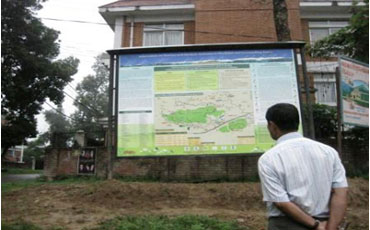
Photo: Tourist Information Board placed in Dhulikhel
Highlights Concerning Output 2:
1. NETIF organized advance training for mushroom production in
Dhulikhel as one of the objectives of NETIF is to support the local
communities and tourism entrepreneurs with training and awareness
programs to increase local livelihoods and enhance the local
environment. The advance training for the production of Button and
Shiitake mushroom was provided by Women Entrepreneurs Association of
Nepal (WEAN) from 16th-19th April, 2013

Photo: Trainer guiding the trainees on mushroom cultivation methods
2. NETIF and NNTDC organized a follow up handicraft training program
in Nagarkot from 23rd April to 28th April. The training was provided
by Women Entrepreneurs Association of Nepal (WEAN) with the aim to
increase women’s participation in economic enterprises through its
various activities of integrated programs of Training. The Training
was given to the disabled women group who had taken the basic
handicraft training which was organized by NETIF in 2012.
3. Food and Hygiene Training organized by NETIF in Sundarijal from
25th-26th April and the training was given by Nepal Vocational
Hospitality Services
4. Eco-club Training organized for TOT (Teach for Trainers) in
Nagarkot and Sundarijal and the training was given by Rotaract
5. Eco club Program ongoing in different schools in SNNP and
Nagarkot
6. Familarization trip was organized for the selective local people
from Nagakot for enhanced capacity building for tourism development
in Homestay program.The Fam trip was made to Ghale Gaun from 4th
-6th April, 2013
7. Capacity building training organized in Shivapuri-Nagarjun
National park.
Highlights Concerning Output 3:
1. On the occasion of World Water Day 2013, Nepal Environment &
Tourism Initiative Foundation (NETIF) with the joint support of
Global Peace Association Nepal (GPA) and Sundarijal Environment &
Tourism Development Society (SETDS) organized a hiking event
“Pristine Origins of the Bagmati River”. The hiking program took
place on16th March 2013, Saturday in Shivapuri Nagarjun National
Park.

Photo: Hiking to Prinstine origin of Bagmati River in Sundarijal
2. Weekly Green desk Mobilization program as an initiation for
environment conservation and waste control is being conducted by
NETIF through Nepal Scout in Sundarijal every Saturday. They also
interact with the local and visitors for awareness.
3. NETIF in association with SEAM Nepal organized Rhododendron and
water way conservation hiking in Sundarijal-Milkharka- Chilaune
route

Photo: Participant of Rhododendron hike event taking a picture of
Rhododendron
4. On the occasion of "Asar Pandra" NETIF in association with
Dhulikhel Rotary organized Rice planting event in Dhulikhel on 29th
June, Saturday.
5. Familarization Hiking trip for Specification and colour marking
on new various Hiking Trails in SNNP
6. Development and publication of Tourist hiking map of SNNP with
Branding and Classification
7. Production of 500 NETIF Himalayan Panoramic posters and 1500
Nepali Brochures
8. Documentation of NETIF’s project NTOEDP from 2008 to present
9. Development of Dhulikhel Picture Book to promote Dhulikhel
tourism
10. Initiation on Development of Tourist information Centre in
Dhulikhel
11. Regular Waste Management in KVCTT
12. Support in Panauti Festival
Highlights Concerning Output 4:
1. Visit to Langtang, Rasuwa for Assessment of upcoming new project
of NETIF
2. NETIF initiation on implementation of Buffer zone management
committee
3. NETIF initiation on implementation of Sundarijal Open Defecation
Free(ODF) zone
4. NETIF’s participation in National Tourism Fair 2013 from 15-17th
February, 2013 in Dhangadi
5. NETIF’s participation in Nepal Tourism Fair 2013 organized by
Nepal Tourism Board (NTB) from 10-12th March, 2013 |